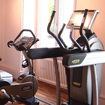Saying/ Asking how you feel
Elementary level
Description
Materials
Main Aims
-
To clarify and practise functional language (say/ask how someone feels)
Subsidiary Aims
-
To revise previously learnt vocabulary words about body parts and illnesses
-
To provide Ss with an opportunity to practise speaking with the target items
Procedure (38-45 minutes)
The teacher greets Ss and places a photo of some ill people on the board. Ss are asked to describe what they see. After eliciting the answers, the teacher hangs another photo of a doctor on the other side of the board. Ss are first invited to describe the photo and then come up with Qs a doctor might ask his/her patients. They are also asked to think what patients might say in return. Ss' suggestions are written on the board.
Once Ss are familiar with the context (ask/say how one feels), they are given a handout which includes the useful phrases written on the board by the teacher. Ss work in pairs to study the phrases and explain to each other if necessary. Then, they are given another worksheet with a reading text. They are asked to find examples of the phrases in that text. The answers are elicited.
Each student is distributed a card that shows how someone feels. Ss are invited to move around the classroom and interact with as many students as possible to ask ''How are you?'' ,''What's wrong?'' etc. The listener is supposed to answer according to the card they have: ''I don't feel well'',''I have a headache''. The teacher models the activity to avoid confusion. Ss are also taught ''Get well soon'' to be able to finish their conversation with a sincere wish.
Ss are instructed to work individually to do Ex 3 and then compare their answers with a partner. CCQs are asked: Are you going to work alone? Yes. Are you going to show your answers to your partner? Yes. The teacher monitors and takes notes for delayed correction. The answers are elicited.
Ss are put into pairs. (Student A and B) and given a card to perform a role play. Student A is ill and tired so s/he can't go to work. S/he has to phone the office and explain. Student B talks to Student A on the phone and responds. The teacher walks around and monitors the pairs in order to offer assistance and support.
The teacher writes some errors made by Ss during the activities on the board. .Ss' attention is focused on these errors and they are asked to correct the errors so that everybody can see the correct usage and learn from each other. Feedback is given.

